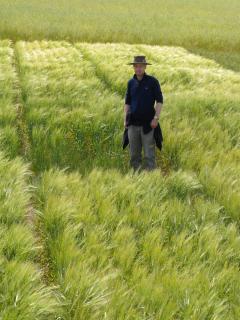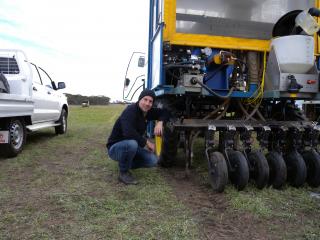Western Australia
February 17, 2015
2015 Western Australian Agribusiness Crop Updates

Department research officer Daniel Hüberli stands amidst rhizoctonia plots as part of research aimed at monitoring soil-borne rhizoctonia on cereal roots and pathogen inoculum levels in the soil, pre-sowing and post-harvest.
Wheat and barley field trials conducted in Western Australia and South Australia from 2011 to 2013 have resulted in a breakthrough in rhizoctonia root rot control and management.
The trials, conducted by the Department of Agriculture and Food and the South Australian Research and Development Institute (SARDI), have identified that two new fungicides, Uniform® and Evergol® Prime, when liquid banded in-furrow under a tine sowing system, significantly improve the control of Rhizoctonia solani AG8.
The research, supported by the Grains Research and Development Corporation (GRDC) and chemical companies Bayer and Syngenta, will be profiled at the 2015 WA Agribusiness Crop Updates in Perth.
Department research officer Daniel Hüberli said the trials assessed yield responses to a range of fungicide treatments, including a split application of fungicide that involved the application of half the fungicide below the sown seed and half on the soil surface.

Department research officer Daniel Hüberli prepares to apply fungicide in-furrow as part of research assessing yield responses to a range of fungicide treatments to control rhizoctonia in cereal crops.
“Liquid banding in-furrow treatments, including the split application, produced more significant yield responses than the Vibrance® seed treatment,” Dr Hüberli said.
“The banding method offers the grower more flexibility and, for the first time, an effective chemical option to control the disease, with yield improvements of up to 50 per cent in wheat and barley crops.
“Registered seed treatments used as comparisons in the trials provided some control of the rhizoctonia root rot when used in conjunction with cultivation and agronomic practices that reduce inoculum levels.
“Yield responses averaged five per cent and were often not significant when compared with the liquid banded treatments.”
But Dr Hüberli stressed that growers should not rely on fungicides as the silver bullet solution to protect their crops from rhizoctonia.
“Fungicide should be used as part of an integrated disease management program which can include sowing a break crop, like canola, chemical fallow and controlling autumn weeds,” he said.
“Other useful strategies include sowing early, soil disturbance 10 centimetres below the seed using knife-points, and ensuring adequate nitrogen.”
Dr Hüberli said a two-year trial in Katanning, conducted as part of the research, confirmed that in paddocks with severe bare-patch, a break crop of canola or clean fallow could reduce both Rhizoctonia inoculum levels and disease in the following cereal crop.
“This outcome is supported by data from five years of monitoring 188 focus paddocks for soil-borne disease on cereal roots and pathogen inoculum levels in the soil at pre-sowing and post-harvest,” he said.
“From 2010 to 2014, inoculum levels of Rhizoctonia pre-sowing and post-harvest were reduced when following canola crops and significantly increased when following cereal crops.
“Barley sown in paddocks with Rhizoctonia exacerbated the disease more than other cereal crops.”
The 2015 WA Agribusiness Crop Updates, hosted by the department and GRDC, will be held at Crown Perth on 24 - 25 February. For further event information visit giwa.org.au/2015-crop-updates or contact the Grain Industry Association of WA office on 08 6262 2128.
The rhizoctonia research will also be presented in coming months at Regional Crop Updates in Salmon Gums, Ravensthorpe, Manypeaks and Badgingarra.
More information on Regional Crop Updates 2015 is available from agric.wa.gov.au/regional-crop-updates-2015 and grdc.com.au/Research-and-Development/GRDC-Update-Dates